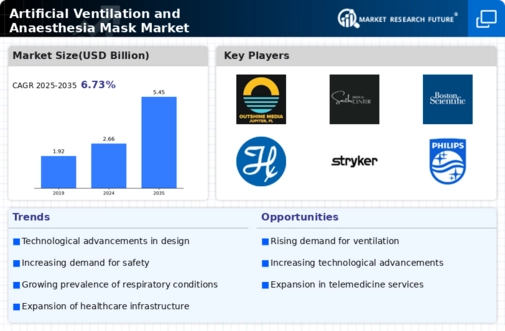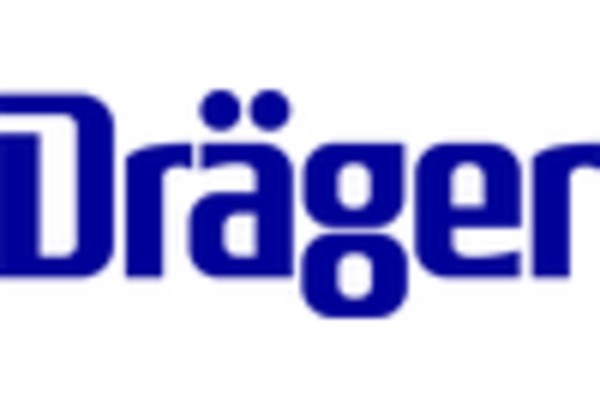Growth of the Healthcare Sector
The expansion of the healthcare sector is a significant driver for the Artificial Ventilation and Anaesthesia Mask Market. As countries invest in healthcare infrastructure and services, the demand for anaesthesia masks is likely to increase. This growth is particularly evident in emerging economies, where healthcare access is improving, leading to a rise in surgical procedures. Additionally, the establishment of new hospitals and surgical centers is contributing to the demand for anaesthesia equipment, including masks. Market projections suggest that the healthcare sector will continue to grow at a steady pace, further driving the need for effective anaesthesia solutions. This expansion presents opportunities for manufacturers to innovate and cater to the evolving needs of the Artificial Ventilation and Anaesthesia Mask Market.
Rising Awareness of Patient Safety
The emphasis on patient safety is significantly influencing the Artificial Ventilation and Anaesthesia Mask Market. Healthcare providers are increasingly prioritizing the use of high-quality anaesthesia masks to minimize risks associated with anaesthesia administration. This heightened awareness is driven by regulatory bodies and healthcare organizations advocating for stringent safety protocols. As a result, hospitals and surgical centers are investing in advanced anaesthesia equipment, including masks that meet rigorous safety standards. Market data indicates that the adoption of safety-compliant anaesthesia masks is expected to rise, reflecting a shift towards prioritizing patient welfare. This trend not only enhances the reputation of healthcare facilities but also propels growth within the Artificial Ventilation and Anaesthesia Mask Market.
Increase in Emergency Medical Services
The rise in emergency medical services (EMS) is significantly impacting the Artificial Ventilation and Anaesthesia Mask Market. As the demand for rapid response in emergency situations grows, the need for effective ventilation and anaesthesia solutions becomes paramount. EMS providers are increasingly utilizing advanced anaesthesia masks to ensure patient stability during transport and treatment. This trend is particularly relevant in urban areas where emergency cases are frequent. Data indicates that the EMS sector is expanding, with an increase in funding and resources allocated to improve service delivery. Consequently, the demand for high-quality anaesthesia masks tailored for emergency use is likely to rise, thereby driving growth within the Artificial Ventilation and Anaesthesia Mask Market.
Increasing Demand for Surgical Procedures
The Artificial Ventilation and Anaesthesia Mask Market is experiencing a notable surge in demand due to the rising number of surgical procedures performed worldwide. As healthcare systems evolve, the frequency of surgeries, including elective and emergency operations, is on the rise. This trend is driven by an aging population and an increase in chronic diseases that necessitate surgical interventions. According to recent data, the number of surgical procedures is projected to grow by approximately 5% annually, thereby increasing the need for effective anaesthesia solutions. Consequently, the demand for high-quality anaesthesia masks is expected to rise, as these devices are critical for ensuring patient safety and comfort during surgeries. This growing demand presents significant opportunities for manufacturers and suppliers within the Artificial Ventilation and Anaesthesia Mask Market.
Technological Innovations in Anaesthesia Masks
Technological advancements are playing a pivotal role in shaping the Artificial Ventilation and Anaesthesia Mask Market. Innovations such as the development of smart anaesthesia masks equipped with sensors and monitoring capabilities are enhancing patient safety and comfort. These advanced masks can provide real-time data on patient vitals, allowing anaesthesiologists to make informed decisions during procedures. Furthermore, the integration of materials that reduce the risk of infection and improve the fit of the masks is becoming increasingly prevalent. As healthcare providers seek to adopt the latest technologies to improve patient outcomes, the demand for these innovative anaesthesia masks is likely to increase. This trend not only enhances the quality of care but also drives growth within the Artificial Ventilation and Anaesthesia Mask Market.


















Leave a Comment